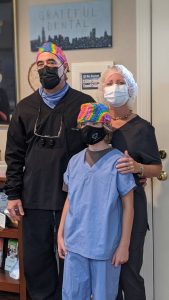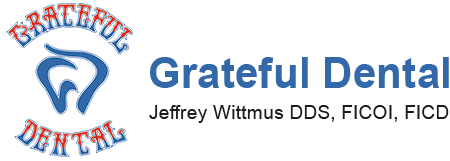 “Mask Mouth” is real! Increased carbon dioxide and decreased oxygen promotes anaerobic bacteria which is the most destructive type of pathogen for periodontal disease and cavities. When the oral pH is low, from GERD, for example, it’s twice as bad. Since hindsight is 2020 let’s revisit some basics heading into 2021. The buildup of bacteria and inflammation of gum tissue, thanks to the mouth breathing that we do inside of masks can be controlled. Drink more water to keep your mouth moist, reduce your consumption of caffeine, scraping your tongue regularly, and not smoking really helps. If you don’t have hot water radiant heat, using a humidifier is also helpful. Instead of using alcoholic mouthwashes, we recommend AO Gel as our favorite brushing and flossing add-on.
“Mask Mouth” is real! Increased carbon dioxide and decreased oxygen promotes anaerobic bacteria which is the most destructive type of pathogen for periodontal disease and cavities. When the oral pH is low, from GERD, for example, it’s twice as bad. Since hindsight is 2020 let’s revisit some basics heading into 2021. The buildup of bacteria and inflammation of gum tissue, thanks to the mouth breathing that we do inside of masks can be controlled. Drink more water to keep your mouth moist, reduce your consumption of caffeine, scraping your tongue regularly, and not smoking really helps. If you don’t have hot water radiant heat, using a humidifier is also helpful. Instead of using alcoholic mouthwashes, we recommend AO Gel as our favorite brushing and flossing add-on.
With all of the mask options available, you might wonder what is an effective mask, and what is the best way to take care of your non disposable mask. ACS Nano published a paper that tested the effectiveness of cloth masks and found that high thread count cotton (600 thread count or higher per inch) filters out 79% of particles smaller than 0.3 microns. (SARS-CoV-2 particles are 0.125 microns in diameter.) They also found that when you layer a high thread count cotton with either polyester, or with two layers of natural silk or chiffon, these “hybrid” masks are 94-97% effective. Single layer or low thread count cotton masks are found to be largely ineffective; 80 thread per inch cotton was found to filter out less than 10% of sub 0.3 microns particles. While HEPA filters are extremely effective, they should never be worn in a mask because they are made with microscopic glass or acrylic fibers which are harmful to the lungs. Please help protect the environment by wearing washable masks, “Wash One, Wear One.” The best way to clean your reusable mask is to wash it in hot water using laundry detergent. Never use bleach because if inhaled, it can damage the respiratory tract. Additionally, it can damage the fabric of the face mask, reducing its effectiveness.
Disposable masks vary in effectiveness and increase waste. Single use masks that have three or preferably four layers with a metal strip at the top to secure the mask around the bridge of your nose. The most effective masks have at least three pleats to enable a good fit around the nose, mouth, and chin. Please dispose of these types of masks after use. These cannot be washed. Be careful with N95s, although they filter 95% of particles 0.3 microns in size, they can be hard to breath in if you are not used to wearing them. KN95 is the Chinese equivalent of these, which is similar, however, much harder to determine authenticity.


